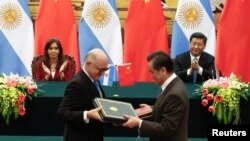China is working to increase its influence in Latin America.
Leaders from the Community of Latin American and Caribbean States were in Beijing last month for talks with Chinese officials. During the meeting, China promised to invest $250 billion in Latin America and the Caribbean over the next 10 years. The two sides set a goal of $500 billion in trade between China and the community’s members during that period.
The trade agreement came shortly after a Chinese company took the first step in plans to build a canal across Nicaragua. The 278-kilometer long canal will connect the Caribbean Sea and the Pacific Ocean. The project is expected to cost $50 billion.
Nicaraguan President Daniel Ortega gave the Hong Kong-based company the right to build and operate the canal for 100 years. But he has faced opposition from Nicaraguans who would be displaced by the project. Foreign critics question whether the new canal is being built to further China’s interests in the area. They note that the Panama Canal is being expanded to let bigger ships pass between the Pacific and Atlantic Oceans.
China becomes a major trading partner
The U.S. Congressional Research Service recently released a report about South America, Central America and the Caribbean Sea. It said the area’s economies have experienced their lowest rate of growth since 2009. But conditions have begun to improve, partly because of trade between China and the Community of Latin American and Caribbean States, also known as CELAC. China recently replaced the European Union as the second largest market for CELAC exports.
Between 2000 and 2013, trade between China and Latin America and the Caribbean jumped from about $12 billion to nearly $275 billion. This trade and investment is mainly in areas related to natural resources and energy, such as oil, copper and soybeans.
The growing partnership between the two sides may also affect efforts to fight global warming, also known as climate change.
China and CELAC are responsible for about 36 percent of what are known as greenhouse gas emissions. Studies have linked the production of such gases to rising temperatures on Earth’s surface.
Military cooperation
Argentine President Christina Fernandez de Kirchner met with Chinese President Xi Jinping on a state visit to China earlier this month. The leaders signed a number of agreements, including one to build two new nuclear power plants.
Argentina is said to be China’s second largest trade partner in Latin America.
The two sides signed a joint military agreement. The deal is said to include weapons and vehicles for Argentina’s army, navy, and air force. China and Argentina may even exchange military officers. China may also build military hospitals in Argentina.
The Argentine leader says the two nuclear plants would be built in Argentina with technology from China. She calls the move, a "gateway for the deepening of this strategic relationship."
The Chinese President agrees. In his words, "both sides are committed to strengthening our cooperation in various fields, especially our cooperation on basic infrastructure development and in promoting the sound and stable development of bilateral trade."
China’s partnership deal with Argentina includes plans to build the biggest space research center in South America.
A new bank for infrastructure development
China is also working with Brazil, Russia, India and South Africa on another project. The five countries, together known as BRICS, want to establish a New Development Bank with $50 billion to pay for infrastructure projects.
The new bank will first finance what officials are calling “sustainable development” in the BRICS countries. But eventually other developing countries will also be permitted to request financial help.
China’s growing relationship with Latin America may help improve how other countries view the Asian power. China’s partnership with CELAC may even have an effect on U.S. economic interests in the area.
I’m Jonathan Evans.
Jonathan Evans wrote this report for Learning English. George Grow was the editor.
________________________________________________________________
Words in this Story
canal - n. a long narrow place that is filled with water and was created by people so that boats could pass through
emission – n., the act of producing or releasing something such as energy or gas
export – n., a product that is sent to another country to be sold there
influence – n., the power to change or affect someone or something; the power to cause changes without directly forcing them to happen
infrastructure – n., the basic equipment and structures (such as roads and bridges) that are needed for a country, area or organization
What do you think about China’s involvement in Latin America? We want to hear from you. Write to us in the comments section.









